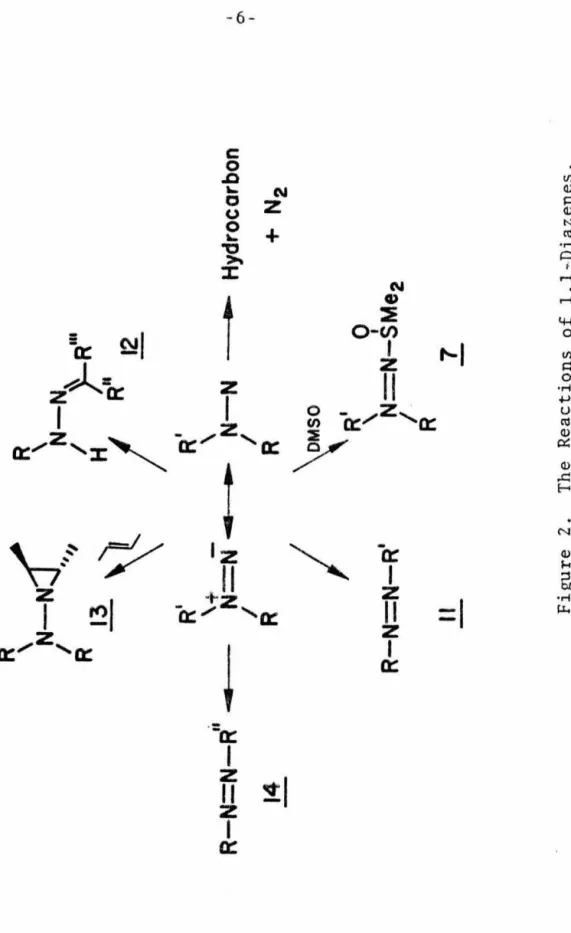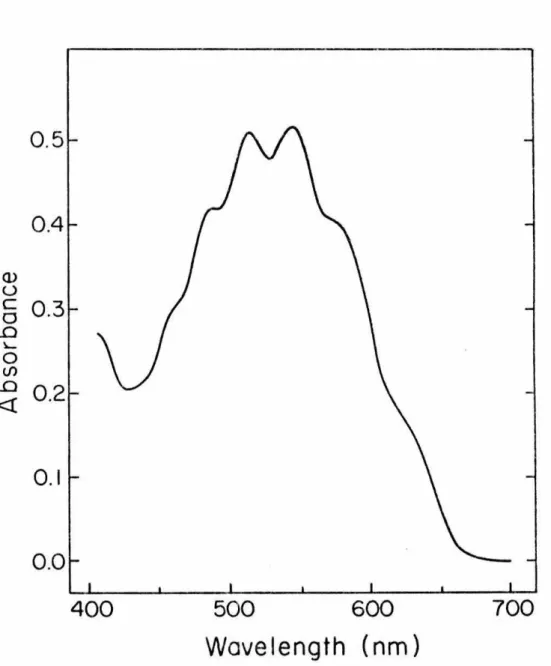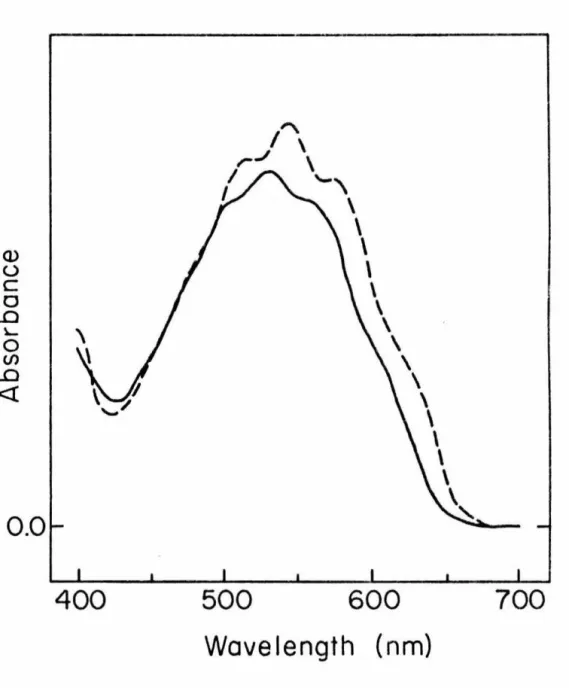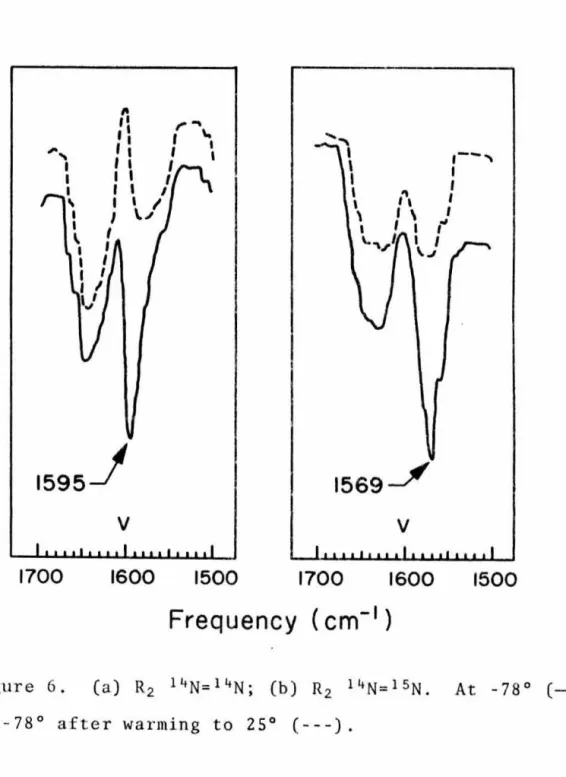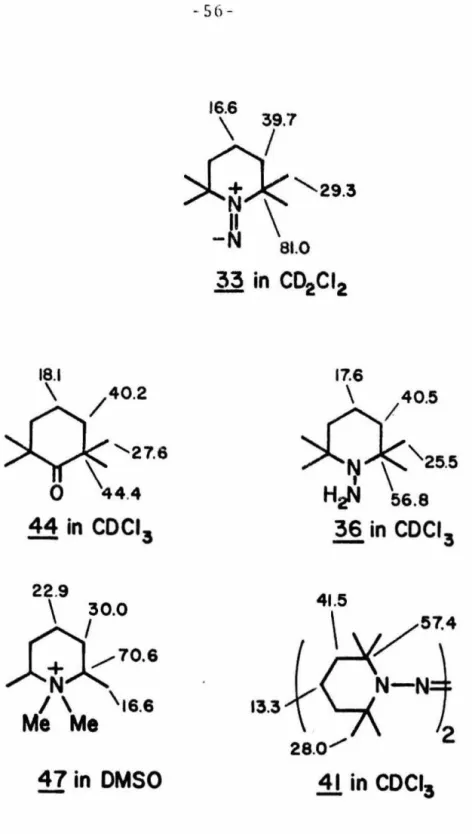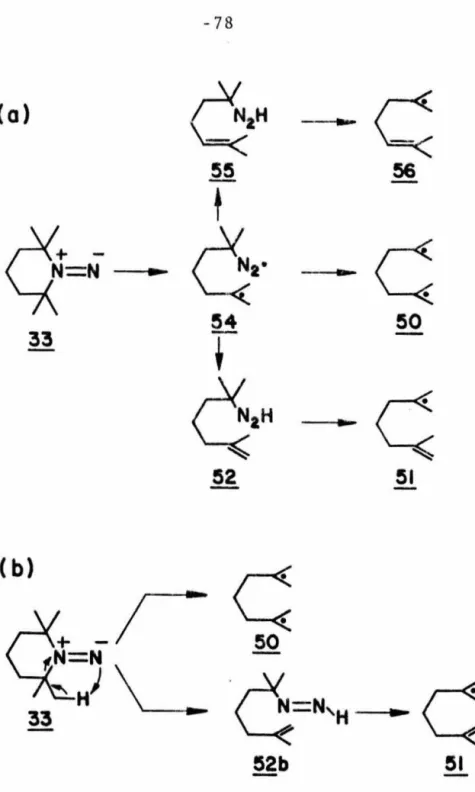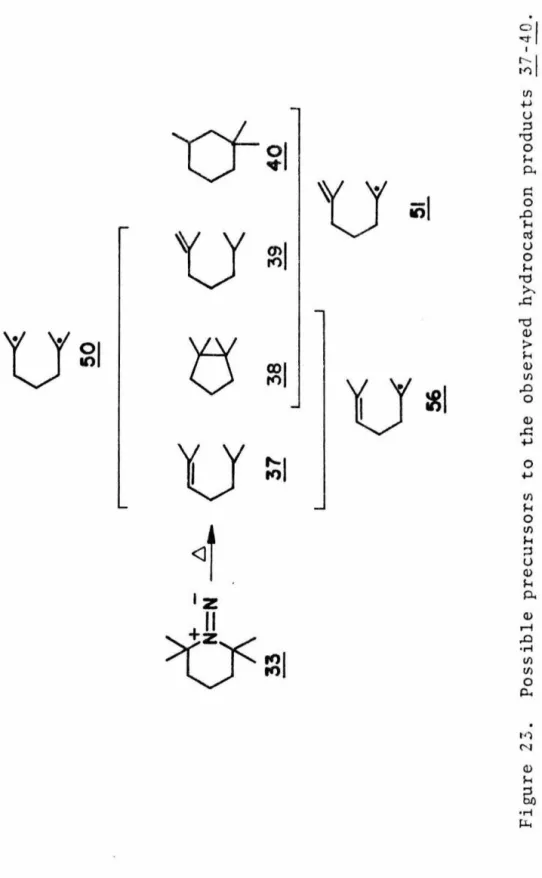I am grateful to the Caltech Chemistry Department staff, who have always been generous with their time and helped me cut through the red tape, and to the technicians. The temperature dependence of the unimolecular rate (k 1) of fragmentation ~ was studied in three different Decomposition of 1,1-disubstituted-2-sulfonylhydrazines (!) in basic protic media or the analogous sodium salts in aprotic media are versatile methods for generating 1,1-.
Subsequent loss of water elements generates diazene.3a Finally, oxidation of 1,1-dialkylhydrazine with curcumin chloride in aqueous solution gave a complex, ~, which released 1,1-dialkyldiazene upon acid treatment, followed by neutralization. 22. 1,1-Diazenes exhibit a rich and diverse chemistry (see Figure 2); the exact mode of stabilization obtained is determined by internal factors (structure and substitution) as well as external factors such as temperature, the nature of the medium and even the rate of addition of re-. Depending on the structural details of the molecule, substituent-assisted fragmentation, concerted fragmentation, or a combination of both may occur.
These results are consistent with disrotatory opening of the l,l-diazene intermediate.2B Analogous low-energy concerted pathways have been used, for example, in the study of the stereochemistry of ortho-xylylene ring closure 29 and as a mild method for the formation of ortho-benzene.
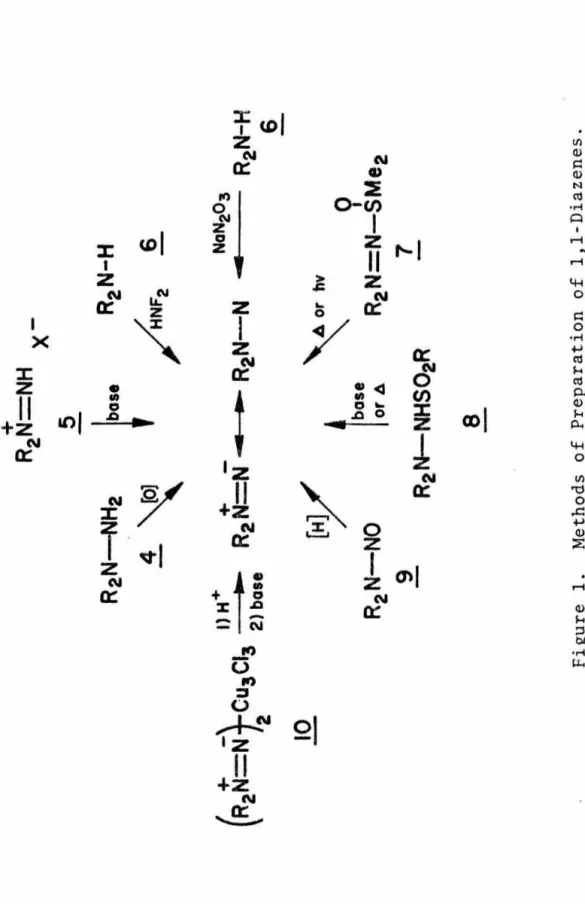
H CHCH 3 E~ )i
1,2-Diazenes have also been shown to arise from 2,3-sigmatropic rearrangements of allyl-substituted 1,1-diazenes. Their early observations have been confirmed and the scope of the reaction expanded by the work of Baldwin and colleagues;34 they provide evidence that the reaction proceeds in a concerted manner, rather than a dissociation-recombination pathway. The bimolecular chemistry exhibited by 1,1-diazenes includes the formation of tetrazenes!!, addition to n-honds, and blocking by sulfoxides.
Although tetrazenes are formally the head-to-head dimers of diazenes, it is likely that under most conditions such coupling does not occur and that the tetracene pro~1ct arises from some alternative pathway.3a For example, the neutralization of solutions of 1, 1-dialkyldiazenium ions lead to the formation of tetrazenes1 2 probably through the reaction of the diazene with a diazenium ion 5. Simple·bimolecular dimerization of 1,1-diazenes probably occurs under certain conditions, for example in the decomposition of 1, 1 -dialkyl-2-sulfonylhydrazine salts in aprotic media.1sb. 36 By analogy with carbene chemistry37 this is generally regarded as evidence that the 1,1-diazene reacts as a singlet and further that the singlet is the ground state.
1,1-Diazenes have been shown to add to both electron-rich and electron-poor olefins .36b, 3B Rees and co-workers have succeeded in adding phthalimido-.
Ill I
The most important question regarding the electronic structure of 1,1-diazene 28 is the nature of the electronic ground state. It is apparent upon an examination of the results that, as calculation methods become more and more sophisticated, e.g. Reference using larger basis sets and extensive configuration interaction), the triplet energy increases compared to the singlet.
This trend is not unexpected; several of the authors explicitly state that the calculation methods they have used tend to overestimate the stability of Pasta and Chiprnan65 performed calculations at the ST0-3G level on the energetics of the homolytic decomposition of 29. The synthesis of the potential 1,1-diazene precursor 1-amino-2,2,6,6-tetramethylpiperidine (36) is straightforward by using a standard nitrosation6 of the commercially available amine l.
For example, c max ~ 14 for the acetone n + n* transition in the vapor phase. B0 In accordance with our assignment of the observed transition as n + n*, we find that the extinction coefficient of 33 at 543 nm in diethyl ether (Emax) is equal to . Q).
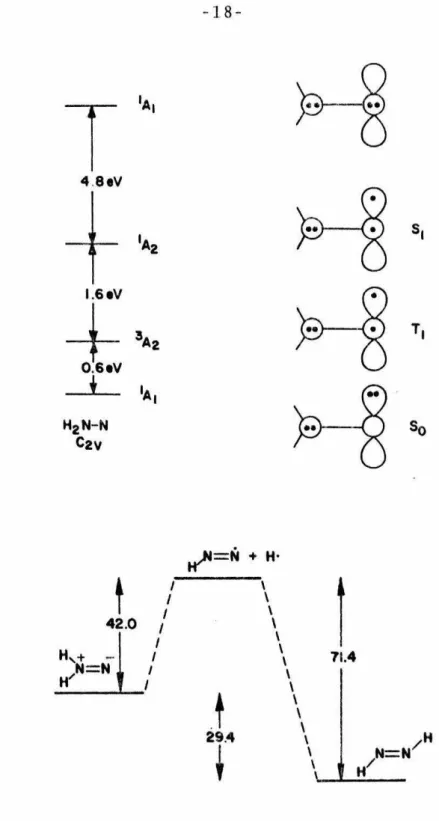
Wavelength (nm)
18 ± 3 measured by a combination of proton NMR and electronic absorption spectroscopy (see Experimental Section). Recently the electronic spectrum of a second 1,1-dialkyldiazene has been recorded in our laboratories by Schultz.81 Oxidation of 1-amino-2,2,5,5-tetramethyl-pyrrolidine CQ) with !_-butyl hypochlorite in a manner identical to that described here gives an intense red solution which is stable for hours at -78° but which quickly decolorizes at room temperature. When !-butyl hypochlorite is allowed to react with 36 in dimethyl ether in the presence of triethylamine and the reaction mixture is filtered, concentrated, diluted with dichloromethane at -78° and placed in a low-temperature infrared cell at ~-78° infra Red. the spectrum shows a strong absorption at 1595 cm-1 that disappears when the solution is warmed to 25° (see Figure 6a). To test this task, application of Hooke's BS Law allows an approximation of.
Frequency
These results suggest that there is significant double bond character in the 1,1-dialkyldiazene N=N bond, remarkably close to a 1,2-diazene isomer. The multiplicity of the 1,1-diazenc ground state and the singlet-triplet gap has been the subject of a number of theoretical and indirect experimental studies. A 0.06 molar solution of 1,1-diazene 33 in chloroform was prepared, degassed and frozen at 77°K in the cavity of an ESR spectrometer.
At 77°K in the solid phase, this absorption appears as a distorted triplet (see inset, Figure 7). A representative spectrum (shown in Figure 8) indicates the presence of a significant amount of tetrazene 41 along with absorptions at o 1.15 and 2.15 ppm which integrate in a 2:1 ratio; these new absorptions are assigned as the methyl protons and the ring protons of the 1,1-diazene, respectively ~· Heating the sample to 25° results in complete decolorization of the sample and the disappearance of the signals at 1.15 and 2.15 ppm, while the tetrazene signals increases and new signals appear in. Thermolysis of the sample at 25° results in the disappearance of the 1,1-diazene signals and the appearance of new absorptions due to tetrazene in l (Figure 11).
The carbon-13 chemical shifts of diazene~ and assignments are summarized in Figure 14 along with the chemical shifts.
Since such data are important for both theorists and experimentalists, a study on the decomposition kinetics of 1,1-diazene was conducted. A comparison of the unimolecular decomposition rates of 33 in the three solvents at the same temperature shows that the rate is sensitive to the nature of the solvent and increases with decreasing polarity of the solvent (see Table 7). A plot plotted against time at the lower temperatures examined is dimerization of the 1,1-diazene 33 in competition with unimo1ecular decomposition.
In the first set of simulations, the values of the uni-molecular rate constants k1 were constrained to the experimental values (determined in the manner described above) within experimental error (±Si). Second, the results indicate that the temperature dependence of the dimerization rate is small. Aliquots of the resulting solutions were thermolyzed at and -20.0° and the hydrocarbon products were analyzed by analytical VPC.
This may simply reflect the variation in the behavior of the groups 51 and 56 or of the diazenyl biradical 54 as a function of the solvent. The low photoreactivity of 33 in the n + n* state is quite surprising given the thermal lability of the 1,1-diazene. Apparently, irradiation of the 1,1-diazene 33 with ultraviolet light forms an upper excited state of the 1,1-diazene, possibly an n + n* state.
Examination of the product mixture by proton NMR and gas chromatography did not reveal the presence of the desired azoalkane. Computer modeling of the kinetics in ethyl ether shows that the experimental data are consistent with competing unimolecular and bimolecular decomposition pathways. The cell body of the IR cell is OFHC copper with stainless steel tubing welded in place.
2 ml and 4-6 ml of the desired solvent (ethyl ether, .~-hexane, dichloromethane or isopropyl alcohol) were cooled to -78° and added to the concentrated solution of 1,1-diazene by means of a stainless steel double - ended needle. After filtration and concentration of the reaction mixture to ~2 mL, 2 mL of dry ethyl ether was added and the resulting solution was stirred. The NMR spectrum of this. thermolyzed sample indicated that all the diacene was converted to tetracene 11pon heating the sample.
Temperatures were determined by means of an iron constantan thermocouple embedded in the body of the spectroscopic cell and connected to a Fluke Model 803B/.
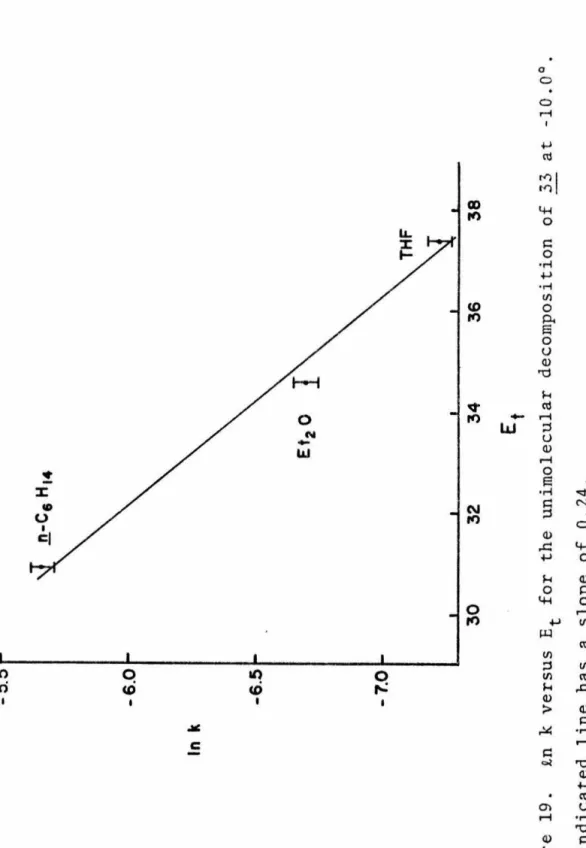
THERMISTOR
Typically, the reaction was followed through ten half-lives; data were analyzed by plotting the logarithm of absorbance versus time. To confirm that a truly first-order process (rather than a pseudo-first-order process) was observed, the following control experiment was performed in each solvent used in this kinetic study: A portion of the 1,1-diazene li stock solution was repeated. The second part of the stock solution was removed and diluted with solvent to a volume of ~ 1.5 t]mes of the original volume.
An electronic spectrum of the resulting stock solution was recorded, showing an optical density of 0.38 at. A 2.2 ml portion of the stock solution was diluted to 4.0 ml with ether (O.D. at 543 nm = 0.20) and irradiated with a 1000 watt focused beam xenon arc lamp operating at 760 watts, e filtered through a solution neodymium/cupric nitrate filterl20 that passed 31% of light at 546 nm (filter bandwidth at half maximum 20 nm); the sample temperature never exceeded -67°. No peaks consistent with the presence of 59 were found, using the retention time of homo-.
The stochastic mechanism simulator MSIM4 developed by Houle and Bunker was used for this simulation.94 Approximate values of the rate constants were obtained. These values were refined by trial and error until a satisfactory fit of the simulation to the experimental data was achieved. Thermal decomposition of 1,1-diazene II · Determination of the effect of solvent and temperature on hydrocarbon product ratios.
After purification by column chromatography at low temperature, 50 tons of triethylamine were added together with 2-3 ml of the respective solvent (hexane, ethyl ether or tetrahydrofuran) and 10.0 pt n-octane as solution. internal standard. Examination of both the volatile and nonvolatile fractions by proton NMR and VPC (UCW-98, 115°) revealed no absorptions or peaks consistent with the presence of the desired azo compound. Proton NMR examination (CDC13) of the non-volatile residue showed a multiplet centered at 6 1.55 and three overlapping singlets centered at 1.05 ppm.
A modification of the procedure of Ohme and colleagues was used. A 500 ml three-neck round bottom flask was equipped with a reflux condenser, an addition funnel and a magnetic stirrer and charged with. Examination of the volatile fraction by visible absorption spectroscopy showed no distinguishing features in the region around 380 nm (azo n + n region).
